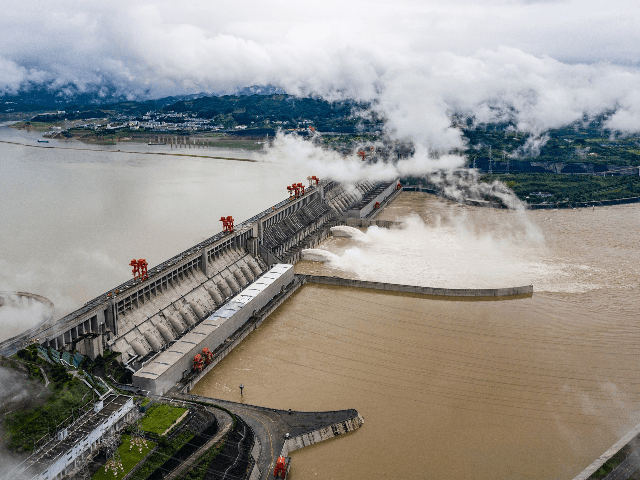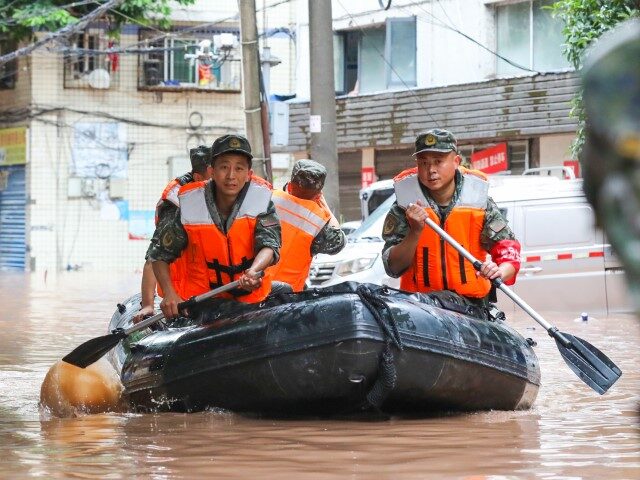Chinese Communist Party authorities scrambled on Tuesday to respond to devastating floods in southwest Chongqing and Sichuan, China, which have forced the evacuation of about 85,000 people and “stranded” another 37,000.
Communist dictator Xi Jinping reportedly warned that all seven of China’s major rivers are in danger of overflowing, expanding the natural disaster beyond the two most affected regions at the moment. Xi organized a meeting of top bureaucratic officials on Tuesday in which he gave a vague command to “enhance coordination, strengthen consultation and research, and improve early warnings and forecasts,” but has otherwise, as in the past, failed to take on any significant leadership role in addressing the crisis.
China has regularly endured a flood season in the summer months for decades, but the intensity and devastation of those floods have increased dramatically in the past ten years, in large part as a result of poorly planned communist constructions of dams. The dams have redirected river flows and endangered both critical farmlands and major cities, as well as creating potential dangers with their poor construction. Chinese authorities have intentionally destroyed dams in recent years – intentionally flooding communities – to protect larger dam projects that appeared to be in danger of collapsing.

This aerial picture taken on June 29, 2020 shows water being released from the Three Gorges Dam, a gigantic hydropower project on the Yangtze river, in Yichang, central China’s Hubei province. (STR/AFP via Getty Images)
“Floods are common during China’s rainy season, which causes annual chaos and washes away roads, crops and houses. But the threat has worsened over the decades,” the Agence France-Presse (AFP) reported in 2021, “due in part to widespread construction of dams and levees that have cut connections between the river and adjacent lakes and disrupted floodplains that had helped absorb the summer surge.’
Despite the evidence of human error exacerbating the damage caused by floods, Chinese state media outlets blamed “climate change” for the currently ongoing disaster in Chongqing.
The Chinese state-run outlet Global Times reported on Wednesday that at least 15 people died in the floods in Chongqing and four are confirmed missing, potentially raising the death toll.
“The local government has sent more than 2,500 people for the emergency rescue and evacuation,” the state newspaper reported. “As of 10 am on Wednesday, some 37,226 people from 36 towns and sub-districts have been stranded and 11,578 of them have been evacuated.”
The Global Times reported on Tuesday that another over 85,000 people in Sichuan had been evacuated as well, bringing the number of severely affected to upwards of 122,000 in the region. Chongqing is a megacity with a population of over 30 million people administered separately from but surrounded by Sichuan province. The newspaper claimed that water levels in Chongqing had receded as of Wednedsday, but elsewhere in the region, “heavy downpours over the past weeks have also displaced thousands, destroyed bridges and washed away cars and homes in Northwest China’s Shaanxi and Southwest China’s Sichuan provinces, as well as Central China’s Henan and Hunan provinces.”
Dramatic videos surfaced on social media on Tuesday and Wednesday showing Chongqing, particularly the Wanzhou district, underwater. Some images showed large buildings crumbling into vast pools of floodwater; others showed attempted rescues of people stranded in their vehicles, clinging to the roofs of cars to avoid being swept away.
🇳 Fifteen people are dead and four are missing after torrential rain lashed the #Chinese metropolis of #Chongqing, local officials and state media said Wednesday.
Take a look at the rescue efforts 👇 pic.twitter.com/FICteeVSXf
— FRANCE 24 English (@France24_en) July 5, 2023
The Global Times reported that the “direct economic loss” attributable to floods in Wanzhou totaled $31 million as of Wednesday. It also predicted, citing Chinese meteorological authorities, that the flooding would continue into August even alongside extreme drought conditions in northern China, particularly Inner Mongolia and Hebei province. The flooding is also expected to affect regions of China thousands of miles away from the general Sichuan area – the government imposed flood warnings on Wednesday in Jilin, Heilongjiang, and Liaoning, the three northeast regions near North Korea and Russia.
Chinese regime-approved “experts” told the state newspaper that “worsening global climate change” was responsible for the damage. One such expert – identified as “Ma Jun, director of the Beijing-based Institute of Public and Environmental Affairs” – noted the presence of the environmental phenomenon “El Niño,” but blamed “worsening global climate change,” Russia’s invasion of Ukraine, and the Wuhan coronavirus pandemic, which originated in China, for worsening flood conditions.
“The global carbon emissions have increased instead of decreased over the past two years as the security of food, energy and supply chains have become many countries’ priority due to the [Wuhan coronavirus] pandemic and the Ukraine crisis,” Ma was quoted as saying.
China took the crown of the world’s worst carbon emitter in 2006 and has remained the world’s worst polluter since then, responsible for about 27 percent of the world’s carbon emissions and 33 percent of the world’s greenhouse gas emissions generally, according to the World Bank.
Every year since 2019 has seen catastrophic flooding in the Chinese heartland. In 2019, social media images of the Three Gorges Dam, the world’s largest hydroelectric plant, appearing to curve under the pressure of high waters prompted international alarm. The Communist Party denied that the dam was under any danger of collapse, insisting it had been built to last for 1,000 years. Fears over the dam – which spans the Yangtse, China’s largest river – extended into the devastating 2020 flood season as Chinese authorities admitted to discharging water from the dam, intentionally flooding neighboring communities, at least nine times in July of that year. Locals reported authorities choosing to flood impoverished communities over wealthier urban areas and failing to properly manage or maintain dam systems for years.
The Chinese government’s Xinhua News Agency boasted on Wednesday that the Three Gorges Dam welcomed a record number of tourists this year, over 50,000 more visitors than the previous record of 1 million tourists documented in 2019.

COMMENTS
Please let us know if you're having issues with commenting.